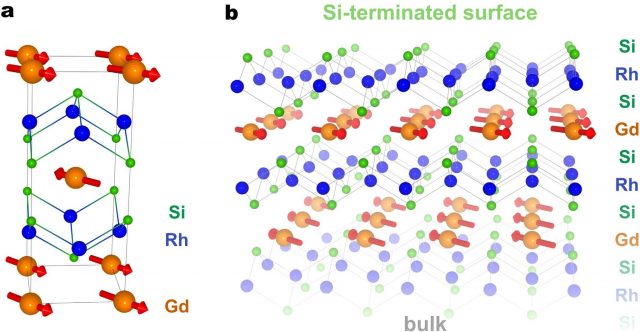Itinerant ferromagnetism at the surface of an antiferromagnet
Silicon surfaces of crystalline solids are part of conventional electronics, but their exploitation in novel materials combining two-dimensional electron states (2DESs) and magnetism, which play an important role in the development of next-generation electronics, still remains elusive. The appearance of 2DESs at surfaces or interfaces and their interplay with magnetic degrees of freedom may open an avenue for new physics in silicon-based technologies for future devices.
In our world, a natural source of very strong magnetism is elemental gadolinium, Gd, which contains a half-filled 4f shell. The characteristics of its ground state makes Gd in crystalline solids insensitive to the crystal-electric-field effects, which may strongly affect the magnetic properties of materials.
Still there are gadolinium-containing materials which are antiferromagnetic. In these substances, below a certain temperature, called the Néel temperature, an ordered array of atomic magnetic moments spontaneously forms in which alternate moments have opposite directions, resulting in a net magnetic moment equal to 0 in the absence of an applied field.
Consider now the layered antiferromagnet GdRh2Si2.. Below the Neel temperature TN ~ 107 K, the Gd 4f moments become ferromagnetically ordered within a plane, while they stack in antiferromagnetic (AFM) order along the perpendicular axis. The Gd planes are well separated from each other by Si-Rh-Si trilayers. Similarly to other RERh2Si2 (RE = Yb, Eu) crystals, the chemical bonds within the trilayer are much stronger than those between the Gd and the Si planes, therefore the surface of a cleaved GdRh2Si2 crystal can be terminated either by Si or Gd atoms. Silicon termination is particularly interesting, since in this case the first magnetically active layer of Gd is hidden and protected by the Si-Rh-Si buffer at the surface.
This leaves us with the question, what happens to the two-dimensional electrons confined at the silicon surface, when the 4f moments of the underlying Gd layer are ferromagnetically ordered? This is schematically illustrated in Figure 1.

This is what an international team of reasearchers, including Mikhail Otrokov, Evgueni Chulkov from Materials Physics Center CSIC-UPV/EHU and DIPC, coordinated by Ikerbasque’s Denis Vyalikh, has been trying to answer1. They found that the silicon surface of GdRh2Si2 reveals a remarkable property, namely, itinerant magnetism at the surface.
The researchers studied this system with angle-resolved photoelectron spectroscopy (ARPES), and found two distinct 2DESs. The study shows that when the Gd 4f moments become ordered, both spectral structures are spin-split and form well-defined subbands.
The authors investigated the momentum-resolved temperature evolution of the spin splitting for both spectral features by ARPES and support their findings with a discussion of their origin and nature with theoretical calculations and X-ray magnetic linear dichroism (XMLD) measurements.
They conclude that the two distinct 2DESs, being an intrinsic signature of the Si-terminated surface of GdRh2Si2, exhibit itinerant magnetism at the surface. Their spin splitting would arise from the strong exchange interaction with the ordered Gd 4f moments lying below the Si-Rh-Si buffer.
The temperature dependence of the spin splitting can be straightforwardly explained within the framework of a conventional model. These results suggest that the ferromagnetic Si-terminated surface of GdRh2Si2 can serve as a model substrate to induce non-trivial electronic and magnetic properties into nanostructures deposited on top, which could eventually become interesting for technological applications.
Author: César Tomé López is a science writer and the editor of Mapping Ignorance
References
- M. Güttler, A. Generalov, M. M. Otrokov, K. Kummer, K. Kliemt, A. Fedorov, A. Chikina1, S. Danzenbächer, S. Schulz, E. V. Chulkov, Yu. M. Koroteev, N. Caroca-Canales, M. Shi, M. Radovic, C. Geibe, C. Laubschat, P. Dudin, T. K. Kim, M. Hoesch, C. Krellner & D. V. Vyalikh (2016) Robust and tunable itinerant ferromagnetism at the silicon surface of the antiferromagnet GdRh2Si2Scientific Reports doi: 10.1038/srep24254 ↩